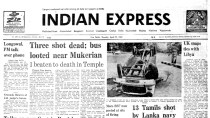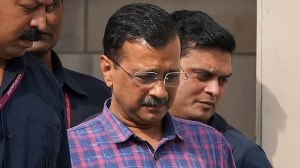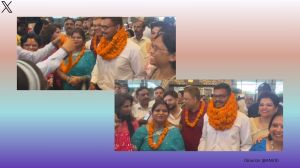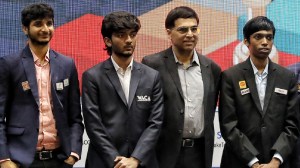- India
- International
Notebandi to Article 370 to Mandir: People must begin all over again, PM Modi will write their destinies afresh
For all the chants and invocations of a past glory, culture and civilisation, the spectacle in Ayodhya was about the leader, here and now: Modi, wearing longer hair and a mask, framed solo, no props or supporting cast, enacting a by-now familiar script of Fall and Rise.
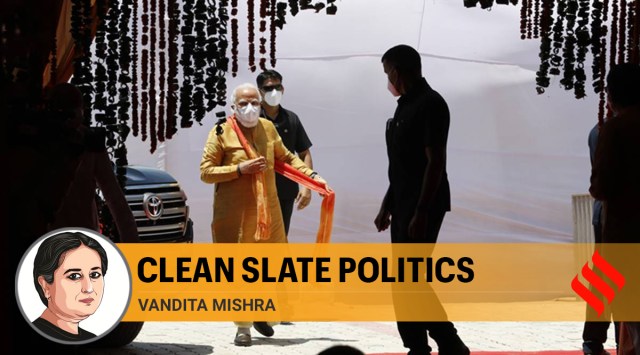 Prime Minister Narendra Modi arrives for the groundbreaking ceremony in Ayodhya (AP)
Prime Minister Narendra Modi arrives for the groundbreaking ceremony in Ayodhya (AP)Many stories will be told of the inauguration of the Ram temple by the Prime Minister at Ayodhya one week ago, exactly a year after India’s only Muslim majority state was stripped of its special status and statehood. One of them is the story of secularism. The silver brick Narendra Modi laid to symbolise the start of temple construction on August 5, just after noon, obscured it from view.
But that temple construction began over the debris of the Babri masjid amid a pandemic, that secularism as it used to be appears to have gone missing during disruption of life as we knew it, is not a work of fiction. Its resemblance to the real-life politics of a leader is not coincidental.
For all the chants and invocations of a past glory, culture and civilisation, the spectacle in Ayodhya was about the leader, here and now: Modi, wearing longer hair and a mask, framed solo, no props or supporting cast, enacting a by-now familiar script of Fall and Rise.
Modi’s politics revels in notions of destruction and creation, and chimeras of the clean slate. Be it the sweep and suddenness of the November 2016 demonetisation; the abrogation of Article 370 by imprisoning the entire existing political leadership in Kashmir 2019; the call for an Atmanirbhar Bharat Abhiyan (Self-Reliant India Mission), even as migrants, abandoned by city and state, walked the long highways to home in May — common to them is a dramatic political imagination imbued with the symbolisms of death and birth and a messianic self-image.
PB Mehta writes: In post-mortem of secularism, we are hand wringing over religion, missing the real crisis

The Hindu vs Muslim story of Ayodhya, seminal as it is, is a play within a play — an inset in the larger before-and-after canvas in which the subjects can be, and are, as in demonetisation, both Muslim and Hindu. Even the so-called aspirational vote for Modi, cutting across caste and class faultlines, is located in this setting. It depends crucially on the imagination of political and institutional rubble and the willing suspension of belief by the people in their own ability to rally what they have, and build on it. All the people must begin all over again, and it is the leader who will write their destinies afresh on a clean slate.
The politics of the clean slate, then, shapes what the people themselves can aspire to. What is hope, and how much can you demand, after all, when everything old must be given up for crumbling or dying, when you are called upon to start from the beginning? Should you be asking the mundane bijli-sadak-pani-padhai-internet-sehat-naukri questions when a grand reconstruction has begun? In a politics where only the leader’s new dawn will deliver, the Opposition, opposing ideas, must be consigned to the night and its shadows.
This framing isn’t new. It has marked the Modi campaigns.
About 270 km from Ayodhya, straddling the border between Uttar Pradesh and Madhya Pradesh, is Chitrakoot — Lord Ram is said to have spent more than 11 years of his 14-year vanvas (exile) in its deep forests. Here, in the last parliamentary election of 2019, lay the perfectly ravaged landscape that Modi’s politics both conjures and performs to. Chitrakoot framed, in miniature, the second Modi majority, which was more emphatic than in 2014.
Opinion | Ayodhya represents a shared sentiment of sacredness
Candidates of all three leading formations in Banda-Chitrakoot — BJP, Congress and SP-BSP Mahagathbandhan — had switched sides, each more than once, with no pretence to a cause larger than themselves.
Nearly 12 years after he was killed in an encounter by the STF, a dacoit called “Dadua” was a vivid presence, and his brother was the Congress candidate. At least four living dacoits, carrying cash rewards on their heads, jostled with Dadua’s legend to influence votes. The bandits, who had risen, according to local lore, by taking on the oppression of the big landlords had, since elections in the 1980s, started to put up their own candidates.
Meanwhile, bonded labour, a long-standing problem targeting the forest dwelling community of Kols, had changed form — local activists pointed to forced migration to the brick kilns of Meerut and Delhi, Punjab and Haryana, and to continuing police oppression of the Kols in the name of fighting the dacoit.
In this denuded setting, the 2019 Modi campaign projected National Security as the issue, and Modi as Saviour, here it invoked Pulwama and Balakot, and won handsomely. On poll-eve in Chitrakoot’s Goswami Tulsidas Degree College, where students lamented the missing jobs, many more said “rashtra suraksha (national security)” was above “rozgar (jobs)” than vice versa.
Opinion | At Ayodhya, we will see dismantling of the old, and the bhoomi pujan of the new republic
Alongside Modi the Protector, was Modi the Benevolent. The BJP campaign, aided by sangathan (party organisation) and sarkar (government), reached out to the people of Chitrakoot as the “labharthi”, beneficiaries of government schemes and of bigger things to come, directly from Modi.
Modi, the Nationalist, also fought and won the election in Chitrakoot — the larger-than-caste figure in a land held hostage to the bareknuckled jati calculus of local rivalries and tyrannies in alternating regimes of the SP and BSP for decades.
Framed in Chitrakoot, then, was the Saviour, Provider and Nationalist, who effortlessly lifted himself above a fray laid low by its dacoits and politicians. Modi’s clean slate politics, that promised grand creation over complete destruction, played resonantly to the Chitrakoot gallery.
Leaders have played a spectral politics to win before. In December 1984, at the end of an Orwellian year — Operation Bluestar, Indira Gandhi’s assassination, killings of Sikhs, Bhopal gas leak — Rajiv Gandhi ran a blisteringly negative Congress campaign that unabashedly played with people’s insecurities and fears, apart from manipulating a sympathy wave.
The Congress harped on threats, foreign and home-grown, to India’s unity and integrity. Its ad campaign, illustrated by barbed wires and reptilian creatures, asked: Why should you feel uncomfortable riding in a taxi driven by a taxi driver who belongs to another state? Will your grocery list in the future include acid bulbs, iron rods, daggers?
PB Mehta writes: Ayodhya’s Ram temple is first real colonisation of Hinduism by political power
Yet Rajiv Gandhi’s oversized victory had all but petered out by the time Bofors dealt it a fell blow in 1987. Perhaps the moment wasn’t ripe, or he wasn’t a good fit in it. In the case of Modi, however, his personal myth slides neatly into his moment.
By the time Modi travelled from the state to the political centre, overwhelming fatigue with the Congress, cynicism about the opportunisms of “secular” politics and the hijacking of “social justice” agendas by corruption or dynasty or both in parties like the SP and RJD, had combined with the damage done by the Manmohan-Sonia division of power to the necessary fiction of democratic accountability.
The Anna Hazare phenomenon was a portent and warning. At Ram Lila Maidan and at Jantar Mantar was a throbbing distrust of and antagonism for politician and Parliament. A sense of catharsis, but even more, of purge. It was on this dishevelled stage that the three-time Gujarat chief minister made his national debut.
Six years later, Modi’s politics, our participation in it, has brought Chitrakoot, that arid place in the no-government’s land between two states, closer to us all. Across the country, the people of Chitrakoot are tailoring their hopes and pegging their aspirations to the politics of the clean slate.
This article first appeared in the print edition on August 12 under the title “Clean slate politics”. vandita.mishra@expressindia.com
Opinion | Ram temple movement has restructured discourse, recast polity
EXPRESS OPINION
Must Read
More Explained
Apr 23: Latest News
- 01
- 02
- 03
- 04
- 05











